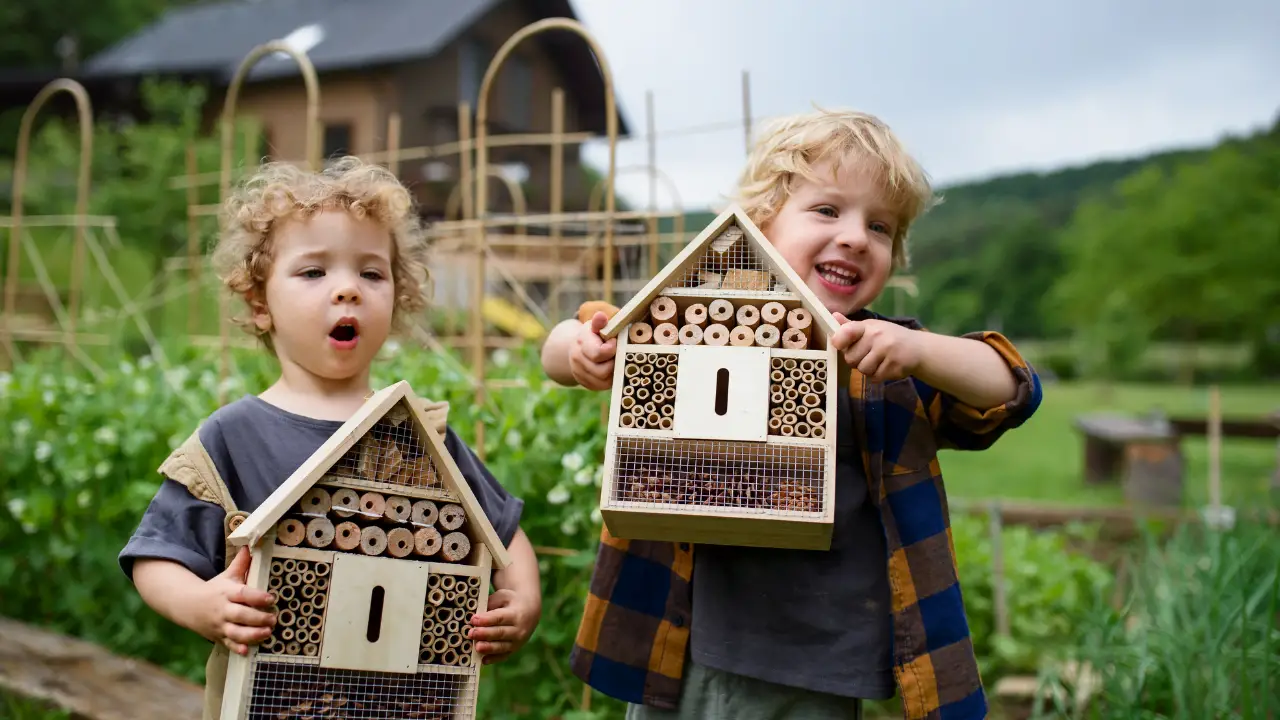Sibling rivalry, a dynamic as ancient as the tales of Cain and Abel, continues to be a pressing concern for many modern families.
While the clashes of yesteryears might be painted on broader canvases of epics and legends, today’s skirmishes over toys, attention, and screen time feel just as monumental.
Navigating these stormy waters might seem daunting, but with the right approach, these conflicts can transform into invaluable life lessons, forging bonds stronger than any adversity.
Dive into our ultimate guide and discover strategies to turn these age-old challenges into harmonious tales of sibling love and understanding.
Some of the links in this post are affiliate links. This means if you click on the link and purchase the item, I will receive an affiliate commision at no extra cost to you. All opinions remain my own. Read more on our Privacy Policy Page
1. The Power of Family Meetings
One of the cornerstones of addressing sibling rivalry is effective communication. Organizing regular family meetings provides a platform for every member to voice their concerns, discuss challenges, and collaboratively seek solutions. In today’s digital age, it’s crucial to have these grounding moments, ensuring each family member feels understood, heard, and valued amidst the noise of modern distractions.

2. Collaborative Games: The Bonding Glue
Games have always been a universal way for people to connect, especially in addressing sibling rivalry. By choosing games centered around cooperation instead of competition, siblings learn the joy and rewards of teamwork. Whether through a strategic board game or a collaborative video game adventure, the emphasis remains on the shared joy of accomplishing goals together.
- “Pandemic” Board Game by Z-Man Games: This game is a fantastic choice for families. Players work together as a team of disease-fighting specialists aiming to treat infections around the world while gathering resources for cures. A true test of collective decision-making and strategy.
- “Forbidden Island” by Gamewright: A collaborative adventure game where players join forces to claim treasures from a sinking island. They’ll have to strategize and pool their resources, making it ideal for siblings to learn to work together.
- “Codenames: Duet” by Czech Games: A two-player cooperative version of the popular word association game, Codenames. It’s a game of hints and guessing where both players work together to uncover the identities of secret agents.
- “Fox in the Forest Duet” by Renegade Game Studios: A cooperative trick-taking card game designed for two players. It involves strategy, prediction, and a joint mission to move through the forest and avoid dangerous paths.
- “Ravensburger The Castles of Burgundy” Board Game: A strategic board game where players work together to build settlements, trade along the river, exploit silver mines, and more. It promotes teamwork and long-term planning.
3. Shared Projects: Two Hands Are Better Than One
Promote activities that require teamwork. Whether it’s cooking a family meal, assembling a piece of furniture, or crafting, these shared projects can become fertile grounds for bonding. The pride of a job done together often overshadows any lingering rivalry.

Shared Projects: Two Hands Are Better Than One
1. Family Garden: Creating a family garden allows siblings to divide responsibilities and collaborate on planting, watering, and eventually harvesting. For instance, older sibling Jake takes charge of tilling the soil while his younger sister Lucy carefully plants the seeds. Not only do they learn about the science of growth, but they also see the tangible benefits of their collective efforts when they harvest their first vegetables.
READ MORE: 10 Fun gardening ideas for sibling – Strengthen sibling bond
2. DIY Craft Projects: Crafting can be a perfect way for siblings to bond. Consider a large scrapbooking project where each sibling contributes by designing their own page or section. James and Mia, for example, spent weekends collecting photographs, trinkets, and memories. While James was good with layouts and designs, Mia had a knack for writing heartwarming captions. Their combined skills turned the scrapbook into a cherished family keepsake.
3. Build-a-Fort Challenge: Encourage siblings to build a fort using blankets, cushions, and furniture. This project requires teamwork, from conceptualizing the design to gathering materials and constructing the fort. When twins Ben and Emma took on this challenge, they discovered that Emma’s attention to detail complemented Ben’s structural ideas. Their joint effort resulted in a cozy reading nook where they’d spend hours together.
4. Diving into Stories of Sibling Bonds
Books can be mirrors, reflecting our realities. By reading stories that delve into sibling relationships, parents can spark conversations about the characters’ actions, leading to valuable insights and discussions about real-life situations.

5. Setting the Ground Rules
A family that understands each other’s boundaries is more likely to live harmoniously. By setting clear expectations about acceptable behavior, parents can prevent many conflicts even before they arise.
- Establish Clear Boundaries: Just as children have their own personal space, they should also understand and respect their siblings’ boundaries. For example, if Anna has a private journal, a rule might be established that no one can read it without her permission. Such a rule reinforces respect for personal space and possessions.
- Shared Responsibilities: When it comes to shared spaces or belongings, responsibilities should be divided fairly. If there’s a shared playroom, siblings Jack and Lily might have a rule that at the end of the day, each one picks up their own toys. This ensures both are responsible for maintaining a clean environment.
- Conflict Resolution: Instead of escalating disagreements, establish a rule that if siblings can’t resolve a dispute on their own, they’ll come to a parent or guardian for mediation. This minimizes shouting matches and encourages dialogue. For instance, when Tom and Jerry dispute over a video game, they know they have a five-minute timer to discuss and find a solution before seeking parental intervention.
- Turn-taking: For shared items or privileges, like watching TV or playing with a particular toy, establish a schedule or a timer to ensure fair turns. For the Smiths, Monday might be Sarah’s day to choose the evening show, while Tuesday is Mike’s pick.
- No Name-Calling or Physical Aggression: Emphasize that disagreements should never turn into personal attacks or physical altercations. If Kate is frustrated with her brother John, she’s taught to express her feelings verbally (“I’m upset because…”) rather than resorting to hurtful actions or words.
- Regular Check-ins: Set up a rule that the family discusses and revises ground rules periodically, ensuring they remain relevant as kids grow and circumstances change. During these sessions, Lucy might bring up that she now needs more study time undisturbed, leading to a new rule about quiet hours.
Establishing these ground rules ensures a fair, respectful environment at home where siblings can coexist harmoniously, learn the value of compromise, and develop a solid foundation for conflict resolution in their future relationships.
6. The Art of Conflict Resolution
Equip your children with the life-long skill of resolving disagreements amicably. Teaching them to communicate feelings, find middle ground, and compromise can turn potential conflicts into opportunities for growth.
READ MORE: Conflict Resolution & Communication

7. Celebrate Unique Achievements
Every child, like every snowflake, is unique. In the realm of sibling rivalry, understanding this uniqueness is crucial. By celebrating individual achievements and highlighting each child’s distinct strengths, parents not only bolster self-worth but also mitigate the urges of unhealthy competition. Recognizing and valuing these differences ensures a harmonious family environment where every member feels acknowledged and cherished.
Celebrate Unique Achievements
Recognizing and celebrating individual achievements is crucial in a family setting, as it instills self-worth and confidence while reducing comparisons and potential envy among siblings.
- Personal Milestones: If your doughter excels in a math competition, while her brother scores the winning goal in a soccer match, both accomplishments should be celebrated. Each child has their own strengths, and recognizing these milestones underscores that every passion and talent is valued.
- Display Achievements: Create a “Wall of Fame” at home where siblings can pin their certificates, artwork, or other tokens of their accomplishments.
- Family Rituals: Establish family rituals around achievements. Maybe every time a child accomplishes something notable, they get to choose the menu for a special dinner. This not only celebrates the achievement but also integrates it into the family’s shared experiences.
8. The Value of Personal Space
Just as adults need ‘me-time’, kids also benefit from individual activities and friendships. By encouraging this, parents can ensure that children have a break from sibling dynamics and develop a strong sense of identity.
Valuing personal space means understanding that everyone needs some alone time and respecting their boundaries. This can be as simple as knocking before entering a room or asking before borrowing something. By doing this, we build trust and show respect for each other’s individual needs and feelings.

9. Strengthening Bonds with Family Traditions
When tackling sibling rivalry, the magic of family traditions plays a pivotal role. From the cozy gatherings during weekly movie nights to the excitement of monthly camping trips or the nostalgia of annual holiday rituals, these traditions are the adhesive that fortifies familial bonds. These cherished moments create shared memories, fostering connections that endure for a lifetime.
- Annual Rituals: Whether it’s a specific holiday celebration, a summer picnic, or an annual game night, these events offer a consistent space for family members to come together, fostering a sense of belonging and continuity.
- Storytelling Nights: Setting aside time for sharing family stories or personal experiences can be an enriching tradition. It not only keeps family history alive but also allows siblings to see different facets of their relatives.
- Special Recipes: Preparing a unique family recipe together, be it for a holiday feast or a Sunday brunch, can be a cherished tradition. The act of cooking together becomes more than just about food; it’s a bonding activity that spans generations.
- Birthday Celebrations: Creating specific traditions around birthdays, like a particular game or a unique way to wake the birthday person, adds an extra layer of specialness to the occasion and strengthens familial ties.
- Regular Outings: Designate a day, like the first Sunday of every month, for family outings. Whether it’s hiking, visiting a museum, or exploring a new place, these shared experiences forge stronger connections.
By embedding these traditions into the family’s routine, siblings grow up with a rich tapestry of shared memories and experiences, which not only enhance their bond but also provide a sense of identity and belonging.
10. When to Seek Professional Help
While sibling rivalry is natural, there are times when the tension might escalate. If this happens, it’s essential to recognize the signs and seek help. Professional therapists or counselors can provide tools and strategies tailored to your family’s needs.
There are times when sibling rivalry or disagreements go beyond the usual quarrels and may need external intervention:
- Persistent Aggression: If there’s recurring physical or verbal aggression between siblings that doesn’t seem to subside with time or intervention, it might indicate deeper underlying issues.
- Signs of Distress: If a child shows signs of anxiety, withdrawal, sleep disturbances, or other behavioral changes, it could be an indication that the rivalry or conflict is affecting their mental well-being.
- Constant Comparison: If one child constantly feels overshadowed or seems to have low self-esteem due to consistent comparisons with a sibling, it may be time to consult a professional.
- Parental Overwhelm: When parents or guardians feel overwhelmed, unable to mediate disputes or are concerned about the intensity of conflicts, seeking guidance can be beneficial.
- Repetitive Patterns: If efforts to resolve issues don’t seem effective and the same negative patterns of interaction persist, it might be a sign that external help is required.
In such situations, a family therapist or child psychologist can provide valuable insights, strategies, and coping mechanisms to help navigate these challenges and foster a healthier family environment.
11. The Importance of Positive Reinforcement
Rather than focusing solely on reprimanding negative behavior, emphasize and reward the positive interactions. By doing this, you’re subtly guiding your children towards better relationship habits.
Positive reinforcement is a powerful tool in shaping behavior and strengthening bonds among siblings.
By acknowledging and rewarding good behavior, parents and guardians can encourage more of the desired actions and attitudes.
This not only boosts a child’s self-esteem but also reduces instances of rivalry or negative attention-seeking.
When children realize that cooperative and kind behavior yields positive attention and rewards, they are more inclined to repeat it.
Furthermore, by emphasizing positive interactions and accomplishments rather than focusing on conflicts, a harmonious family environment is cultivated, where each child feels valued and motivated to contribute positively.

12. Walking in Their Shoes
Role-playing can offer invaluable insights, allowing siblings to understand each other’s perspectives better. It’s a creative way to resolve conflicts and foster empathy.
Empathy is a foundational pillar in building and maintaining harmonious relationships, especially among siblings. Encouraging children to “walk in their sibling’s shoes” fosters an understanding of each other’s feelings, perspectives, and challenges. By role-playing or discussing scenarios where they imagine themselves in their sibling’s place, children can gain a deeper appreciation for their emotions and reactions. This practice not only reduces misunderstandings and conflicts but also nurtures compassion and tolerance. Over time, by regularly emphasizing the importance of understanding and empathizing, siblings can develop stronger bonds, characterized by mutual respect and a genuine concern for each other’s well-being.
>> Enhance Sibling Bonding with Our Recommended Products!
13. Fostering a Culture of Empathy
Empathy is the cornerstone of any healthy relationship. By engaging in activities that emphasize understanding and compassion, parents can ensure that siblings grow up with a strong sense of empathy.
- Active Listening: Encourage family members to truly listen when someone speaks, without immediately jumping to solutions or judgments. This validates feelings and demonstrates genuine concern.
- Emotion Vocabulary: Help children expand their vocabulary around emotions so they can articulate and understand their feelings and those of others better.
- Empathy Role-Playing: Engage children in role-playing exercises where they switch roles with a sibling, allowing them to see situations from different perspectives.
- Sharing and Reflection Time: Dedicate time where each family member shares their day or experiences, and others reflect back what they’ve heard, fostering understanding.
- Modeling Empathy: Children learn by example. When parents or guardians showcase empathetic behavior—be it in comforting a distressed child or understanding a teenager’s challenges—it sets a strong precedent for the children to emulate.
14. Ensuring Equal Attention
Balancing attention between siblings can be challenging, especially when their needs differ. However, it’s crucial to make every effort to provide equal attention, ensuring that no child feels sidelined.
- Individual Quality Time: Dedicate time for each child separately. This might be reading a book, going on a walk, or indulging in an activity they love. This one-on-one time reassures each child of their unique place in the family.
- Acknowledge Individuality: Celebrate each child’s unique interests and achievements without drawing comparisons. If one excels in sports and the other in arts, ensure both achievements are acknowledged independently.
- Avoid Labels: Avoid categorizing or labeling children, like “the smart one” or “the athletic one.” Such labels can inadvertently lead to imbalances in attention and perceived value.
- Joint Activities: Engage in activities where all siblings can participate together, ensuring that each child has a role. This fosters collaboration while ensuring everyone feels included.
- Open Communication: Maintain open channels of communication. If a child feels they’re getting less attention, they should feel comfortable voicing their feelings, ensuring timely intervention.
- Rotate Responsibilities: If certain tasks or privileges (like choosing a movie for family night) are desirable, rotate them among siblings to ensure fairness.
By consciously ensuring equal attention, parents and guardians lay the foundation for a balanced family environment, minimizing feelings of resentment and fostering mutual respect among siblings.

15. No Comparisons Allowed
Every child is unique. By avoiding comparisons and treating each child as an individual, parents can reduce feelings of competition and jealousy.
In the journey of addressing sibling rivalry, understanding the dangers of drawing comparisons between siblings is paramount. Such comparisons can unknowingly sow seeds of resentment, competition, and feelings of inadequacy. Recognizing the uniqueness of each child, from their passions to their individual development pace, is essential. By avoiding the trap of comparison, parents and guardians can bolster the self-worth and individual value of each child. Embracing and celebrating the distinct accomplishments and characteristics of every sibling fosters a family environment where each member is truly valued for their authentic selves.
>> SIBLING BONDING GAMES AND ACTIVITIES
16. Respecting Personal Boundaries
Addressing sibling rivalry head-on is crucial for nurturing a harmonious family environment. By instilling the principles of boundaries, both emotional and physical, and emphasizing the respect for each other’s personal space and belongings, parents can pave the way for stronger, healthier relationships among siblings.
In Conclusion
Navigating the intricacies of sibling rivalry is a journey many families embark upon. It’s a path filled with bumps, sharp turns, and occasional crossroads, but it’s also laden with opportunities for growth, bonding, and enduring love. By incorporating strategies like fostering empathy, valuing personal space, and ensuring no comparisons are drawn, families can turn potential pitfalls into stepping stones for deeper connections.
In our modern, fast-paced world, where distractions are plenty, focusing on the nuances of sibling dynamics becomes even more vital. Remember, it’s not just about mitigating rivalry but about crafting lifelong bonds and memories. With conscious effort and guidance, sibling rivalry doesn’t have to be a perpetual challenge but can be transformed into a catalyst for stronger familial ties.






